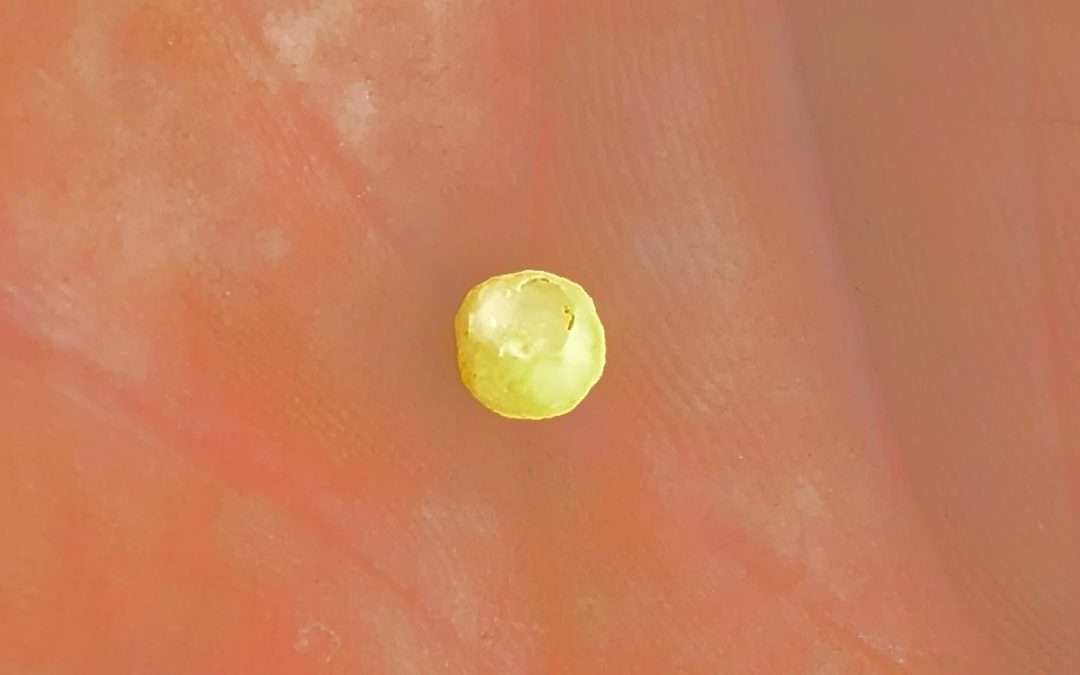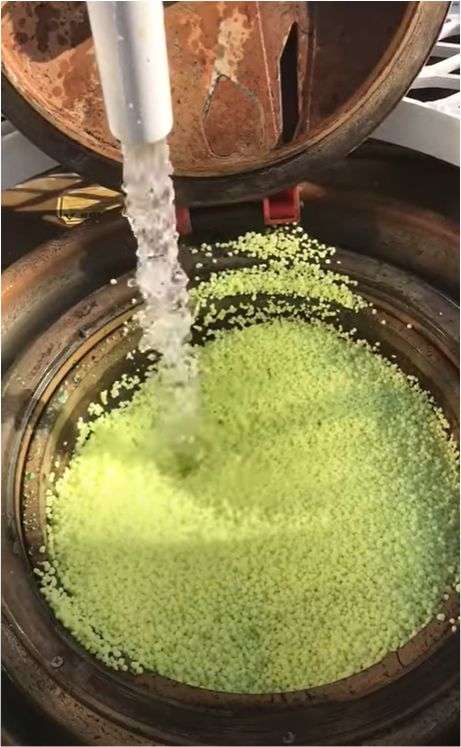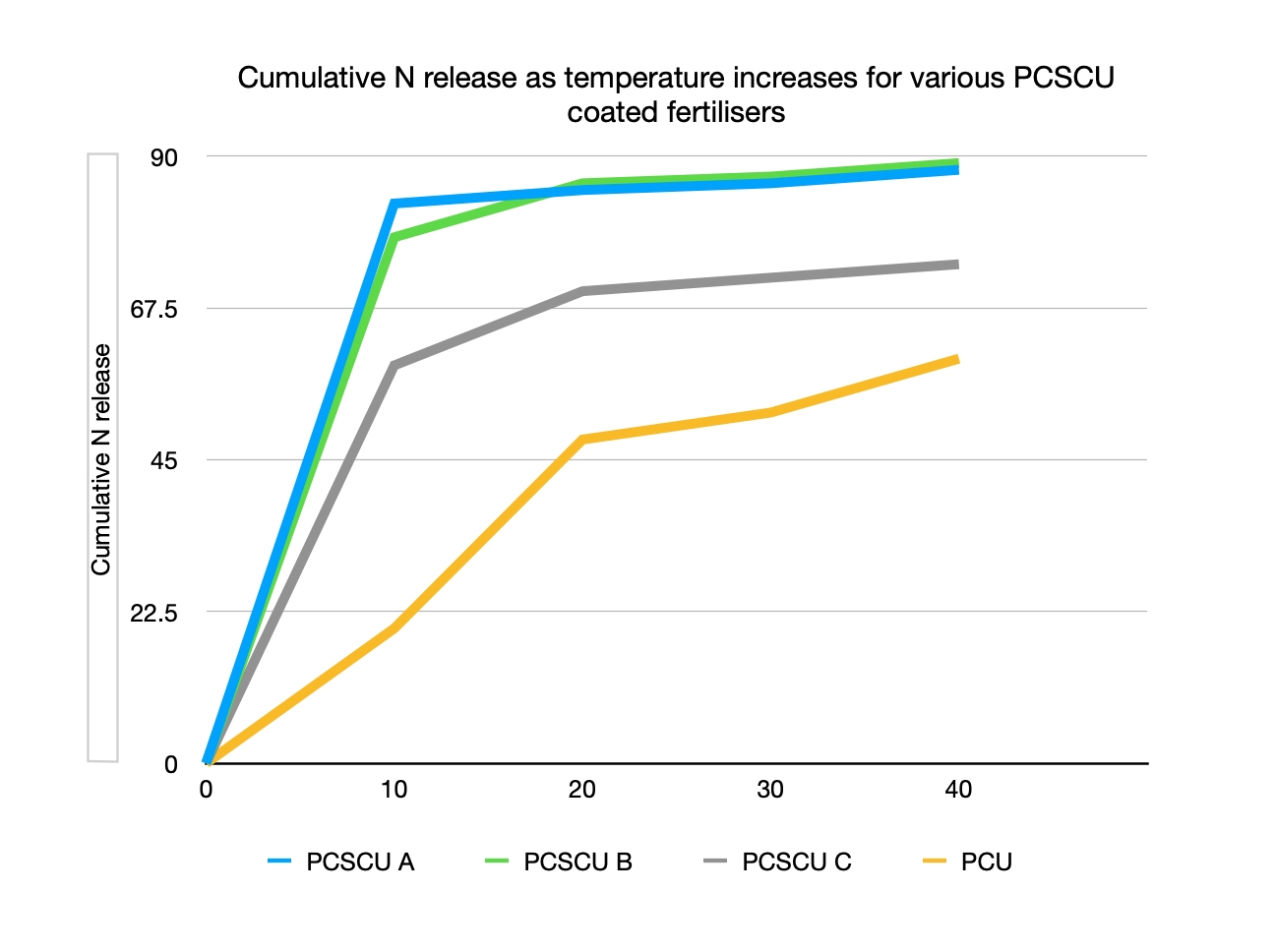Firstly, not all slow-release fertilizers for lawns are the same, and there are now several alternatives on the market that are slow-release grass fertilizers. Each slow-release grass fertilizer and slow-release fertilizer for lawns has advantages and disadvantages.
Jerry Spencer, our Head turf agronomist, has over 15 years experience in fertilizer manufacturing in Australia. So he is in a good position to cut through the marketing and explain your options.
For example the picture above is of a low-quality prill (granule) of a sulphur coated urea (PCSCU) granule that is supposed to last up to 8 weeks. Within 4 days of application, it has released its contents (dumped).
If you want to read up on slow release fertilisers in more detail this should be of interest.
The Gilba turf blog has a several other articles that may be of interest such as how to select a fertilizer, urease inhibitors and nitrification inhibitors.
Slow release Fertilizers
Slow-release fertilizers are just one class of turf fertilizers available to the turf manager.
There is a massive amount of confusion as to what slow-release fertilizers are. This blog will clarify what they are, how they work, and what is involved in choosing the right fertilizer.
The main advantages of slow-release fertilizers are:
- Firstly, an increased turf safety as these are less likely to burn turf. Sirflor 38 is an excellent example of this.
- Secondly, a long-term growth response without surge growth. This results in less need to mow;
- Thirdly, a decrease in lush, disease-prone turf and lastly
- They have less environmental impact as there is less waste.
How these products work is a serious consideration when you develop any fertilizer strategy aiming to produce high quality turf.
What is a slow release grass fertilizer?
You can divide slow-release fertilizers into organic and synthetic products.
Products classified as organic in Australia, include those based on poultry manure, such as Dynamic Lifter®, Neutrog®, Terrafirma®, and Queensland Organics®. These are all pelletised manure, which is either heat-treated or composted to remove excess moisture. Subsequently, end moisture levels can vary from 8–16% depending on the brand and manufacturing process.
There are three groups of synthetic slow release grass fertilizers:
- Synthetic slow-release nitrogen compounds.
- Inorganic fertilizers treated to decrease their solubility and
- Nitrification and urease inhibitors.
In this blog we are going to focus on the first two as slow release fertilizers for lawns available. We will discuss the organic slow release fertilizers and nitrification/urease inhibitors at a later date.
Slow release fertilizers for lawns
In the home garden market, a slow release fertilizer seems to be anything that says it is a “slow-release grass fertilizer” on the packaging.
This makes things very unfair for companies selling a “true” slow-release fertilizer for lawns.
For example, Product A can only include 5% slow release and be marketed directly against product B, which contains 80% slow release.
Based on the bag price Product A is cheaper, although it contains a significantly lower % of slow-release compared to Product B, despite both products claiming to be slow release! Consequently, always carefully check the label.
Things to be aware of when buying a slow release fertilizer for lawns:
- When costing a slow-release grass fertilizer, always make sure you are comparing apples with apples. Granule size can make products with a similar analysis vary dramatically in price. As a point of note slow-release fertilizers marketed as containing IBDU are now only available in the country as Floranid® in a greens grade prill.
- Huge claims of longevities. Always ask for the data to support any claims. As the Australian fertilizer industry is pretty much self-regulated, you rely on the honesty of the supplier;
- The packaging gives little information about the actual slow-release content.
Synthetic Slow Release Fertilizers.
Synthetic slow-release fertilizers, overcome the disadvantages of organic products, like unpredictable release. In the table below lists the synthetic slow release grass fertilizers used in Australia. Regard UF38 as the same as MU.
All have slightly different release characteristics and contain differing percentages of slow-release N. So any one product isn’t always the best in every situation. However, some a better suited to certain situations.
How slow-release fertilizers work.
Slow-release fertilizers are mainly focused on nitrogen.
UF 38 and MU slow-release fertilizers
Ureaform contains around 38% nitrogen. During manufacture several ureaforms can be separated based on their solubility in cold and hot water.
Depending on the release time, nitrogen availability is divided into four segments based on the amounts of Cold Water Soluble Nitrogen (CWSN), Hot Water Soluble Nitrogen (HWSN), and Hot Water Insoluble Nitrogen (HWIN). At a temperature of 25°C, it is the CWSN fraction that turf uses.
The greater the percentage of hot water-soluble and insoluble nitrogen the longer the release. The long-chain fractions release nitrogen over several weeks or months and the shorter-chain fractions are available from a few days to several weeks.
| Type of Release | Approximate length of release (weeks) | Fraction |
| Fast | 2-3 | Cold Water soluble nitrogen (CWSN) |
| Moderately Fast | 3-5 | Cold Water soluble nitrogen (CWSN) |
| Slow | 5-9 | Hot water-soluble nitrogen (HWSN) |
| Very Slow | 7-10 | Hot water-insoluble nitrogen (HWIN). |
The release mechanism of UF and MU slow-release fertilizers is by microbial activity. The warmer the temperature, the quicker the release. However, above a certain temperature microbial activity stops, and so does nitrogen release.
The other key product characteristic is that if the granule becomes broken or crushed, it doesn’t affect how the nitrogen is released.
So regardless of the particle size, it behaves the same.
One further point. If you ever buy a box of grass seed containing blue fertilizer granules, that’s UF38. The reason they use this is that it is not water-soluble and it has a low salt index.
The lack of water solubility means that if the packaging gets wet or the product is stored in far from ideal conditions it won’t release.
The low salt index means that it does not affect seed germination.
IBDU.
With this slow-release fertilizer for lawns, nitrogen release is does not rely on temperature. Temperature has a big effect on urea-formaldehyde and natural organic products but little effect on IBDU.
Consequently in cool weather, this gives good winter and early spring colour. The amount of moisture and particle size affect the amount of nitrogen release.
As the surface area increases, smaller particles dissolve more rapidly. There is a five-fold increase in N release after eight weeks when particle size decreases from 3–4 mm to 0.3–0.6 mm. Also, be aware that fertilizers containing IBDU can ‘smear’ over the surface once they become wet, which is an issue on closely cut turf.
In Australia, IBDU is available as Floranid® (BASF). In Victoria and the ACT, it is the best slow release fertilizer for feeding in late autumn and winter.
PCSCU/SCU slow release fertilizers
This is apopular slow release grass fertilizer. By coating urea with a membrane, the membrane slowly breaks down by degradation due tomicrobial, chemical and physical processes. The membrane reduces the availability of the nitrogen from the urea.
Coating urea with sulphur has become popular because:
- Even after coating, a high nitrogen fertilizer like urea gives an end product having a N content of around 30–40%.
- Coating urea with sulphur reduces leaching and volatilisation.
- Sulphur is relatively cheap.
- Sulphur is itself a valuable secondary nutrient.
The PCSCU and SCU release N by the action of water moving into fertilizer granules. It does this via micropores and imperfections such as cracks or poor sulphur coverage in the coating.
Once water enters, the urea core rapidly dissolves. Subsequent variations in temperature cause the granules to swell, crack and release their contents. The higher the temperature, the greater the swelling and the faster it releases.
Problems with Sulphur Coated urea
Problems can develop with sulphur-coated slow-release fertilizers, such as rapid release if the coating cracks and a likelihood of excessive soil acidification. Once a granule cracks or becomes damaged, it loses it is no longer a slow-release fertilizer.
To help reduce the brittle nature of SCU, companies apply a thin polymer layer to the prills.
Particles with a thick sulphur coat show fewer imperfections than particles with thinner coats. There is a risk, however, that particles with too thick sulphur coatings will exhibit “lock-off” and may never effectively release their nitrogen.
The other reason to apply a polymer coat is it gives a more predictable N release.
In the home lawn market, PCSCU products make some pretty big claims with regard to length of release.
Depending on the coating weight, application rate and environmental conditions, sulphur-coated ureas can have residual characteristics that give a release of 6 to 12 weeks in turfgrass applications.
For example, if it is over 30°C it will release faster than at 15°C. Subsequently, the quality of the PCSCU has the biggest impact on release times.
PCSCU and SCU slow-release fertilizers are easy to see in a slow-release lawn fertilizer. These are yellow or orange granules that are through the product.
Because of the uneven coating thickness and the influence of temperature on nitrogen release, some low-quality brands can cause severe turfgrass mottling during the cool-season growth period.
Other slow-release grass fertilizers.
There are fertilizers you can class as being slow release due to the slowness of their physical breakdown. Examples of these include:
- Granomag (magnesium oxide); a high-analysis magnesium fertilizer containing 57% Mg. Granomag is used in fertilizer blends to increase the Mg content, but it is useless to address any short-term deficiency as it is insoluble;
- Potassium polyhalite. Potassium polyhalite contains 16% S as sulphate, 11.6% K as from sulphate of potash, 3.6% Mg from magnesium sulphate and 12% Ca as from calcium sulphate;
- Pearl technology. Pearl is magnesium ammonium phosphate hexahydrate and has an analysis of 5-28-0 with 10% Mg. More info here.
The image below shows how temperature affects the release of three different PCSCU turf fertilizers. Products A and B release faster than Product C as the temperature increases. PCU refers to polymer-coated urea which is a premium coated option, and offers a stronger prill plus a more consistent release.

Jerry Spencer
Graduated from Newcastle University with an Hons Degree in Soil Science in 1988, Jerry then worked for the Sports Turf Research Institute (STRI) as a turf agronomist before emigrating to Australia in 1993.
He followed this by gaining a Grad Dip in Business Management from UTS. He has worked in a number of management roles for companies as diverse as Samsung Australia, Arthur Yates and Paton Fertilizers.
He has always had a strong affinity with the Australian sports turf industry and as a result he established Gilba Solutions as an independent sports turf consultancy in 1993. Jerry has written over 100 articles and two books on a wide range of topics such as Turf Pesticides and Nutrition which have been published in Australia and overseas.






